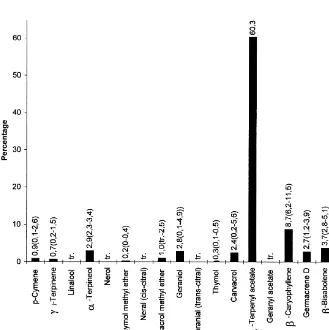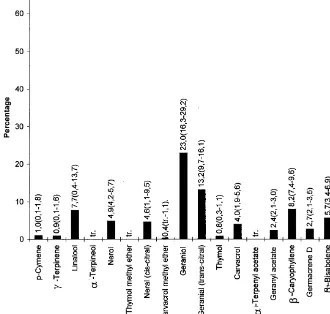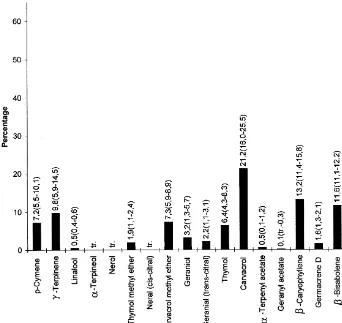*Corresponding author.
E-mail address:[email protected] (D. Mockute).
The
a
-terpenyl acetate chemotype of essential oil
of
Thymus pulegioides
L.
Danute Mockute
*
, Genovaite Bernotiene
Institute of Chemistry, Goshtauto 9, LT-2600 Vilnius, Lithuania
Received 12 October 1999; received in revised form 1 February 2000; accepted 28 February 2000
Abstract
The composition of the essential oils ofThymus pulegioidesL. plants growing wild in Vilnius district (Lithuania) with`estera, lemon and carvacrol (phenol) odours were collected in one location and investigated by GC, GC/MS and IR-spectroscopy. The essential oils with lemon and carvacrol odour belong to corresponding known citral}geraniol and carvacrol chemo-types. The essential oil of plants with`esteraodour containing 50}70% ofa-terpenyl acetate belong toa-terpenyl acetate chemotype, which was not noticed earlier inThymus pulegioidesL. species. ( 2000 Elsevier Science Ltd. All rights reserved.
Keywords: Thymus pulegioidesL.; Essential oil;a-terpenyl acetate chemotype
1. Introduction
The chemical polymorphism of essential oils of Thymus genus plants has been reviewed (Stahl-Biskup, 1991; Lawrence, 1998a, b; Corticchiato et al., 1998). More than 20 essential oil chemotypes were noticed in di!erent species ofThymusgenus and eight chemotypes were determined forThymus pulegioidesL. Thymol and carvacrol chemotypes of essential oil were found in Norway and Romania; thymol, citral, linalyl acetate and fenchone chemotypes in Czechoslovakia (Stahl-Biskup, 1991). Thymol and carvacrol chemotypes were later found in Yugoslavia (Kustrak and Martinis, 1990). The essential oil ofT. pulegioidesL.plants growing wild in Croatia contained geraniol (44.6%) and linalool (28.6%) as the main components (Mastelic et al., 1992).
Twelve localities were investigated in Slovakia (Marton", 1992; Marton"et al., 1994). Carvacrol, thymol, citral-geraniol, linalool and fenchone chemotypes of essential oil were found (Marton" et al., 1994). All"ve chemotypes were found in two of the 12 localities. The other 10 localities displayed fewer chemotypes. A thymol chemotype was found in Italy (Senatore, 1996). The investigation of 10 localities of Vilnius district (Lithuania) show that the main chemotypes of essential oil ofT. pulegioides L. were citral}geraniol and carvacrol (Mockute and Bernotiene, 1997, 1998a, b, 1999). The analysis of essential oil of 10 plants growing wild in one locality of Vilnius district shows that the"ve plants were carvacrol chemotype, 2-thymol and 1-geraniol (Loziene, 1997). Investigators of essential oil from separate branches of T. pulegioides L. and T. praecoxOpiz plants collected in Slovakia discovered polymorphism in one plant. The essential oils of branches of the same plant contain di!erent quantities of constituents. The composition of essential oil in one branch ofT. praecoxdi!ers from that of other branches by the absence ofb-caryophyllene which forms'15% of essential oil in some branches (Mechtler et al., 1994).
a-Terpenyl acetate has not been found in large quantities in early investigations of T.pulegioidesL. plants, but it has been found in others species of theThymusgenus. The essential oil of plants ofT. longicaulis(Baser et al., 1993),T. herba baronaLois (Corticchiato et al., 1998) and in some samples of T. willkomii (Adzet et al., 1976) contain'50% of a-terpenyl acetate. This compound, in quantities'20%, was determined in essential oils from more than "ve species (Baser et al., 1996a, b; Corticchiato et al., 1998; Tzakou et al., 1998).
The essential oils fromT. pulegioides L. plants with three di!erent odours were analysed in this work.
2. Materials and methods
The samples ofT. pulegioidesL. were collected at full#owering of plants according to their odour in the location near a boundary of Sapiegine and Rokantishkes. The samples of the plants with lemon and carvacrol odour weight&1 kg, with `estera odour 0.1}0.2 kg. The plants were air-dried at the room temperature (20}253C). The essential oil (0.1}0.3%) was prepared by hydrodistillation of 10}100 g of air-dried plants.
The GC analysis was carried out with a Hewlett-Packard (HP) 5890 II gas chromatograph equipped with a#ame ionization detector and a fused silica capillary column (25 m]0.2 mm) coated with FFAP (Hewlett-Packard) stationary phase. The oven temperature was programmed from 70 to 2103C at 33C min~1 using He as a carrier gas (0.7!ml min~1). Injector and detector temperatures were 2003 and 2503C, respectively.
Table 1
Constituents of three chemotypes of essential oil ofThymus pulegioides L. growing in one locality of Vilnius district (Lithuania)!
a-Terpenyl acetate Citral}geraniol Carvacrol
Component 1996 1997 1998 1995 1996 1997 1995 1996 1997
p-Cymene 0.1 0.1 2.6 0.1 1.8 1.1 6.1 10.1 5.5
c-Terpinene 0.6 1.5 0.2 0.1 1.0 1.6 5.9 14.5 9.1
Linalool (0.1 (0.1 Tr 9.1 13.7 0.4 0.6 0.4 0.5
a-Terpineol 3.4 2.9 2.3 Tr Tr Tr
Nerol Tr 5.7 4.2 5.6 Tr Tr Tr
Carvacrol 0.2 1.4 5.6 5.6 1.9 4.4 16.0 25.5 22.2
a-Terpenyl acetate 70.4 61.2 49.5 Tr 0.2 1.2 0.1
Geranyl acetate Tr Tr (0.1 2.6 3.0 2.1 0.1 Tr 0.3
b-Caryophyllene 6.2 8.5 11.5 7.6 9.6 7.4 15.8 11.4 12.4
Germacrene D 1.2 2.9 3.9 2.4 2.1 3.5 2.1 1.5 1.3
b-Bisabolene 2.8 3.2 5.1 3.4 6.8 6.9 11.1 12.2 11.4
Caryophyllene oxide 0.9 1.9 2.3 8.1 5.0 2.4 3.6 2.6 5.4
Total 89.3 34.5 91.4 80.1 92.1 92.4 92.8 96.1 93.3
!Order of elution on apolar column HP-5MS, percentage on polar column FFAP. All compounds were identi"ed using data on the both columns and GC/MS.a-Terpenyl acetate chemotype was investigated using the above methods and IR-spectra.
The percentage composition of the essential oil was computed from GC peak areas without using correction factors. Qualitative analysis was based on the comparison of the retention data on both columns and mass spectra with that of the corresponding components of reference oils and the data in the literature (Chung et al., 1993; Zenkevich, 1996, 1997).
The IR-spectra of essential oils ofa-terpenyl acetate chemotype were recorded on Specord 71.
3. Results and discussion
The samples of plants were collected according to their odour. The plants with
Fig. 1. Mean chemical composition ofThymus pulegioidesL. essential oil ofa-terpenyl acetate chemotype. For each constituent minimum and maximum values of percentage are given.
investigation. Apart from this locality, the odour of 40}100 ofT. pulegioidesL. plants were investigated in 11 localities of the Vilnius district. The plants with`esteraodour were not found in the above 11 localities and they formed only&5% of plants of the investigated locality.
Fig. 2. Mean chemical composition ofThymus pulegioidesL. essential oil of citral}geraniol chemotype. For each constituent minimum and maximum values of percentage are given.
higher in the essential oil of carvacrol chemotype. The mean of b-caryophyllene exceeds 8.0% in all investigated chemotypes. This compound is characteristic for all"ve chemotypes of T. pulegioides L. growing wild in Slovakia (Marton" et al., 1994). b-Caryophyllene is not characteristic of some species of Thymus genus. Seven chemotypes from eight investigated, including a-terpenyl acetate chemo-type of T. herba barona Lois, did not contain b-caryophyllene (Corticchiato et al., 1998).
Fig. 3. Mean chemical composition ofThymus pulegioidesL. essential oil of carvacrol chemotype. For each constituent minimum and maximum of percentage are given.
limonene (tr.) and (E)-b-ocimene (0.1}0.9%). The same compounds, exceptb-ocimene, were found in very low quantities in essential oils of the citral}geraniol chemotype in the location under investigation.
The composition of the essential oils of citral}geraniol (Fig. 2) and carvacrol chemotypes (Fig. 3) investigated here are similar to chemotypes identi"ed in Eastern Slovakia (Marton", 1992) and in other localities of the Vilnius district (Mockute and Bernotiene, 1997, 1998a, b, 1999). The main components of the essential oil of the citral}geraniol chemotype are geraniol, citral (geranial#neral) andb-caryophyllene (Fig. 2). Low quantities of 1-octen-3-ol, b-bourbonene and spathulenol were also identi"ed in this essential oil.
Vilnius district (Table, Fig. 3, Mockute and Bernotiene, 1998b, 1999). There is no information about the presence of carvacrol methyl ether and b-bisabolene in the essential oil ofT.pulegioidesL. growing wild in Slovakia (Marton", 1992; Marton"
et al., 1994). 1-Octen-3-ol was found in the essential oil of the carvacrol chemotype in addition to the above-mentioned compounds.
Nineteen compounds were identi"ed in the essential oil of thea-terpenyl acetate chemotype of T. herba barona Lois (Corticchiato et al., 1998). The investigated essential oils of this chemotype contain&90 compounds of which 25 were identi"ed. Beside compounds given in Table 1 and additional monoterpene hydrocarbons previously mentioned "ve more compounds, 1-octen-3-yl acetate, bornyl acetate, b-bourbonene, a-humulene and nerolidol, were identi"ed. Thirteen compounds (sabinene, myrcene, limonene,c-terpinene, p-cymene, linalool, bornyl acetate, neral, a-terpineol,a-terpenyl acetate, geraniol, geranyl acetate, geraniol) are common in the essential oil ofT. herba baron Lois (Corticchato et al., 1998) and T. pulegioidesL. (Table 1). These compounds form more than 70% of essential oils ofa-terpenyl acetate chemotype. The above data make it possible to propose that the mechanism of formation of chemotypes in di!erent species of theThymusgenus may exhibit the same biosynthesis of terpenes and terpenoids.
References
Adzet, T., Granger,, R., Passet, J., San Martin, R., 1976. Chimiotypes deThymus hiemalisLange. Plantes Med. Phytother. 10, 6}15.
Baser, K.H.C., Ozek, T., Kirimer, N., Tumen, G., 1993. The occurrence of three chemotypes ofThymus longicaullisC. Presl. Subsp.longicaulisin the same population. J. Essent. Oil Res. 5, 291}295. Baser, K.H.C., Kirimer, N., Ermin, N., Ozek, T., Tumen, G., 1996a. Composition of essential oils from three
varietes ofThymus praecoxOpiz growing in Turkey. J. Essent. Oil Res. 8, 319}321.
Baser, K.H.C., Kirimer, N., Ermin, N., Kurkcuoglu, M., Tumen, G., 1996b. Essential oils from four chemotypes ofThymus zygioidesGriseb. Var.lycaonicus(Celak) Ronniger. J. Essent. Oil Res. 8, 615}618. Chung Yung, T., Eiserich, J.P., Shibamoto, T., 1993. Volatile compounds isolated from edible Korean
chamchwi (Aster scaberThumb). J. Agric. Food 41, 1693}1697.
Corticchiato, M., Tomi, F., Bernardini, A.F., Casanava, J., 1998. Composition and infraspeci"c variability of EO fromThymus herba baronaLois. Biochem. Syst. Ecol. 26 (8), 915}932.
Kustrak, D., Martinis, Z., 1990. Composition of the essential oils of someThymusandThymbraspecies. Flavour Fragrance J. 5, 227}231.
Lawrence, B.M., 1998a. Progress in essential oils. Perfumer Flavorist 23, 39}50. Lawrence, B.M., 1998b. Progress in essential oils. Perfumer Flavorist 23, 63}82.
Loziene, K., 1997. Morphological characteristics and essential oil analysis ofThymus pulegioidesL. in the habitat of hilly landscape of Vilnius vicinities. Lietuvos jaunuju botaniku darbai, Vilnius 141}151 (in Lithuanian, abstract in English).
Marton", P., 1992. Polymorphism of essential oil onThymus pulegioidessubsp. chamaedrys in Slovakia. J. Essent. Oil Res. 4, 173}179.
Marton", P., Grejtovsky, A., Repc\ak, M., 1994. Chemotype pattern di!erentiation ofThymus pulegioideson di!erent substrates. Biochem. Syst. Ecol. 22, 819}825.
Mastelic, C., Grzunov, K., Kravar, A., 1992. The chemical composition of terpene alcohols and phenols from the essential oil and terpene glycoside isolated fromThymus pulegioidesL. grown wild in Dolmatia. Riv. Ital. EPPOS. 3, 19}22.
Mockute, D., Bernotiene, G., 1997. Essential Oil of lemon scentedThymus pulegioidesL. grown wild in Vilnius district. Organine chemija. Kaunas, Lithuania97-100 (in Lithuanian, abstract in English). Mockute, D., Bernotiene, G., 1998a. Compounds causing the odour ofThymus pulegioidesL. grown wild in
Vilnius district. Neorganine chemija ir technologija. Kaunas. Lithuania 141}145 (in Lithuanian, abstract in English).
Mockute, D., Bernotiene, G., 1998b. Essential oil of lemon-scentedThymus pulegioidesL. grown wild in Vilnius vicinity. Rastitelniye resursy 34 (1), 131}134 (in Russian, abstract in English).
Mockute, D., Bernotiene, G., 1999. The main citral}geraniol and carvacrol chemotypes of essential oil of Thymus pulegioidesL. growing wild in Vilnius district (Lithuania). J. Agric. Food Chem. 47 (9), 3787}3790.
Senatore, F., 1996. In#uence of harvesting time on yield and composition of the essential oil of thyme (Thymus pulegioidesL.) growing wild in Compania (southern Italy). J. Agric. Food Chem. 44, 1327}1332. Stahl-Biskup, E., 1991. The chemical composition ofThymusoils: a review of literature 1960}1989. J. Essent.
Oil Res. 3, 61}62.
Tzakou, O., Verykokidou, E., Roussis, V., Chinou, I., 1998. Chemical composition and antribacterial properties ofThymus longicaulissubsp. chaoubardii oils: three chemotypes in the same population. J. Essent. Oil Res. 10 (1), 97}99.
Zenkevich, I.G., 1996. Analytical parameters of essential oil components for GS and GC-MS identi"cation. Mono- and sesquiterpene hydrocarbons. Rastitelniye resursy. 32(1}2), 48}58 (in Russian, abstract in English).



